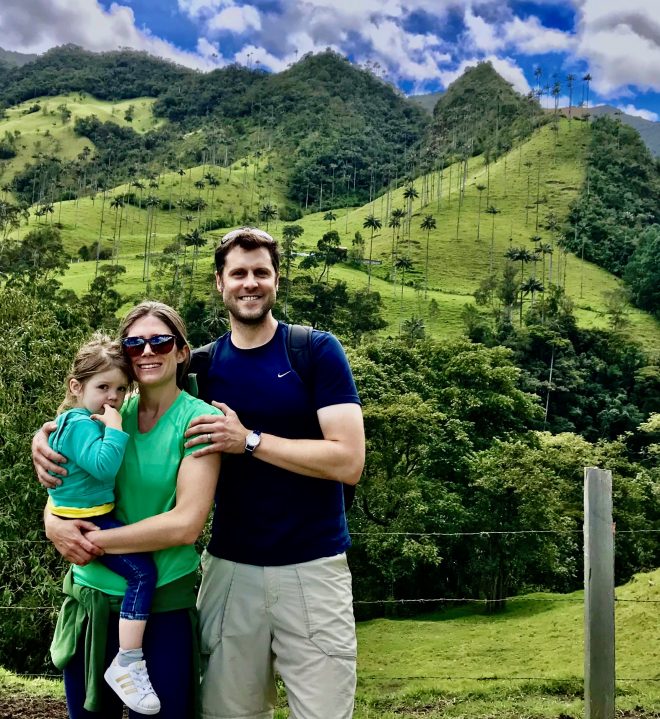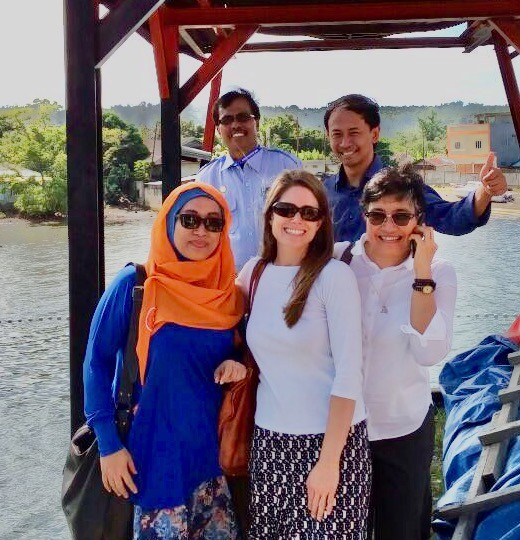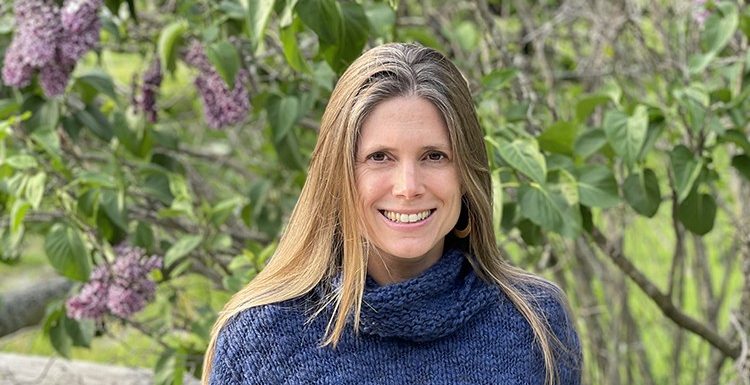Now in our 10th year of work, we’ve hit another milestone: we’ve hired our first executive director, Alyson Welch! Aly has jumped in and is getting fully immersed in our food security and livelihoods work. Originally from Vermont, Aly has lived and worked in different states and countries over the past 15 years, and she’s thrilled to return to her home state and join the Food 4 Farmers team.
Aly’s 15 years of experience in development, primarily in Latin America, gives our organization a fresh, knowledgeable perspective on a variety of issues, particularly her responsibility for a large portfolio of USAID-funded projects focused on environmental, economic development, governance, and land rights issues.
We sat down with Aly to find out more about her work, her plans for the future, and her relationship with coffee.
What drew you to leave Washington, DC and return to Vermont to work for Food 4 Farmers?
I’ve followed Food 4 Farmers for years. I’ve been a big fan of the organization’s community-driven approach right from the start. When I saw the posting for an executive director, I knew it would be a wonderful opportunity to return to my Vermont roots, and apply what I’ve learned working with communities across the world, to lead a non-profit organization with a focus on a region close to my heart: Latin America.
working with communities across the world, to lead a non-profit organization with a focus on a region close to my heart: Latin America.
Along with working in places like Indonesia, the Philippines, Macedonia, and throughout Latin America, I lived in Mexico City for two years before moving to DC. While I love the offerings of big cities, it’s great to return to Vermont and be closer to family. Seeing my daughter play in our yard, look for bugs in the garden, and get excited to plant strawberries, has been incredible! The pandemic impacted all of our lives in unexpected ways, and it definitely made me want to return to my roots. Though I do dream of spending part of the year in Mexico someday, it feels really good to be back in Vermont, even if seeing three bears in my yard the other day was a little scary.
What appeals to you about Food 4 Farmers’ approach?
I value our commitment to communities and the fact that farming families play a leading role in the design and implementation of our programs. Our community partners are involved every step of the way, right from the beginning, when we perform a diagnostic with community members to understand the local context and their experiences around food insecurity — the causes, challenges and potential solutions. That’salways the basis of the multi-year work plan we develop together that addresses those causes, with yearly targets they can use to measure their progress. The community truly is the driver of each program. It’s this level of investment and commitment that has made the work continue successfully during upheavals like political unrest in Nicaragua and Colombia, climate disasters like hurricanes or drought, or the pandemic, when our team had to quickly transition to a virtual model of support. When a co-op and coffee-farming families take co-ownership of designing and implementing food security and livelihoods work, we can build programs that are truly sustainable, and locally rooted. And, after spending the past 10 years managing projects designed to be implemented for only 3 to 5 years, I really value the flexibility of our approach. We can support our community partners as long as they need us–whether it’s 2, 4, or 10 years. Most root causes of food insecurity can’t be solved in the short-term, so our partners benefit from our longer interventions.
How did your professional background and experience prepare you for this work?
Early in my career, I was a community outreach coordinator at a non-profit that worked to improve the well-being and health of immigrant communities. I really enjoyed helping community members identify and resolve issues important in their daily lives, and it was inspiring to see the impact that our efforts had on the community. A few years later, I began my career in international development at a large consulting firm. I oversaw projects based in Guatemala, Nicaragua and Colombia, where I had a myriad of responsibilities, and traveled internationally to work with staff and local partners and governments. In 2013, I moved to Mexico to take on a full-time role on a project that worked with at-risk youth in border cities and strengthened the capacity of the Mexican government and local organizations to prevent crime and violence.
These experiences let me see firsthand the inner workings of development projects, learn best practices, and identify areas for improvement. I worked closely with community members, national and local governments, civil society organizations, and the private sector. They also helped prepare me for my role at Food 4 Farmers, as I manage and collaborate with diverse teams and stakeholders, monitor and evaluate performance, oversee financial matters, and build on progress in a fluid, multinational environment.
What do you see as the key issues facing rural communities in Latin America? How is Food 4 Farmers addressing these issues?
Several projects I managed before joining Food 4 Farmers focused on a variety of issues in Latin America, including crime and violence prevention, local governance, access to justice, migration, and economic development. These all impact the current instability in parts of the  region, but climate change, in my opinion, is one of the most concerning issues and is closely linked to the others. We now know that climate change can lead to more migration, cause more violence against women and lead to greater economic inequalities. Before joining Food 4 Farmers, I managed a portfolio of projects based in Honduras, which was heavily impacted by hurricanes Eta and Iota that hit the region in November 2020. Some of our staff members and their families lost their homes and everything they owned, and the impact on the country was devastating, with nearly half of the population affected. The FAO estimates that the hurricanes affected approximately 8.3 million people in Guatemala, Honduras and Nicaragua, including the agricultural livelihoods of more than 700,000 families who lost their harvests and experienced irreversible damages to their crops.
region, but climate change, in my opinion, is one of the most concerning issues and is closely linked to the others. We now know that climate change can lead to more migration, cause more violence against women and lead to greater economic inequalities. Before joining Food 4 Farmers, I managed a portfolio of projects based in Honduras, which was heavily impacted by hurricanes Eta and Iota that hit the region in November 2020. Some of our staff members and their families lost their homes and everything they owned, and the impact on the country was devastating, with nearly half of the population affected. The FAO estimates that the hurricanes affected approximately 8.3 million people in Guatemala, Honduras and Nicaragua, including the agricultural livelihoods of more than 700,000 families who lost their harvests and experienced irreversible damages to their crops.
The effects of climate change–these hurricanes, combined with increased droughts and rising temperatures throughout the region– and the impact of the pandemic, have exacerbated the challenges facing rural communities already struggling to make a living and put food on the table.
If temperatures continue rising, it’s likely we’ll continue to see an increase in natural disasters, including hurricanes, and these rural communities and the surrounding ecosystems that produce the products we love–coffee, avocados, tomatoes, and more — will continue to be impacted and more livelihoods put at risk.
Since coffee is a crop that is very susceptible to climate change, our work with coffee-farming communities in Latin America to promote livelihood diversification and agroecological farming is key to not only helping them develop resilience and adaptive skills to withstand the impending impacts of climate change, but to also have the ability to continue growing coffee.
When did you start drinking coffee, and what are some of your favorite coffee-growing regions? What’s your go-to coffee shop order?
I was a late bloomer when it comes to coffee; I didn’t start drinking it until I was a student at the University of Vermont, trying to balance playing field hockey and completing my studies. It wasn’t until 2007, when I met my husband — who was a barista during high school and loved coffee — that I really started learning about it. Since then, every vacation and work trip has included a visit to a local café or coffee farm to taste coffees grown in the region and meet the producers. In 2013, we saw firsthand the impact of coffee leaf rust at a cooperative in Aldea Tzampetey, Guatemala. Before the pandemic, we spent a week in the Eje Cafetero in Colombia, visiting the departments of Quindo, Risaralda and Caldas, and stayed on a coffee farm.
coffees grown in the region and meet the producers. In 2013, we saw firsthand the impact of coffee leaf rust at a cooperative in Aldea Tzampetey, Guatemala. Before the pandemic, we spent a week in the Eje Cafetero in Colombia, visiting the departments of Quindo, Risaralda and Caldas, and stayed on a coffee farm.
I generally prefer a lighter roast, and love coffee from Oaxaca, Mexico and Huila, Colombia; both regions produce such balanced and lively cups. Having spent the last three years working in Honduras, I was able to try some amazing coffees from the country’s diverse growing climates. One of my favorite roasters there is Cafe Nativo, based in Tegucigalpa. They have an amazing selection of coffee from small-scale producers throughout Honduras.
Have you been wanting to travel again? Where would you like to go first?
I can’t wait to visit our project sites! I’ll be in Guatemala later this year and plan to visit our partners at Acodihue and Maya Ixil. Personally, I’m itching to return to Oaxaca. We usually travel to Mexico at least once a year, and Oaxaca is one of our favorite destinations. Since we couldn’t travel in 2020, I’ve been traveling vicariously through music (I’ve been listening to a lot of Lila Downs) and cooking–I made enchiladas verdes from scratch recently and was ecstatic to find tomatillos in our local grocery store. My next project is to make tortillas from scratch!




